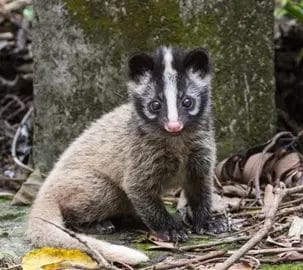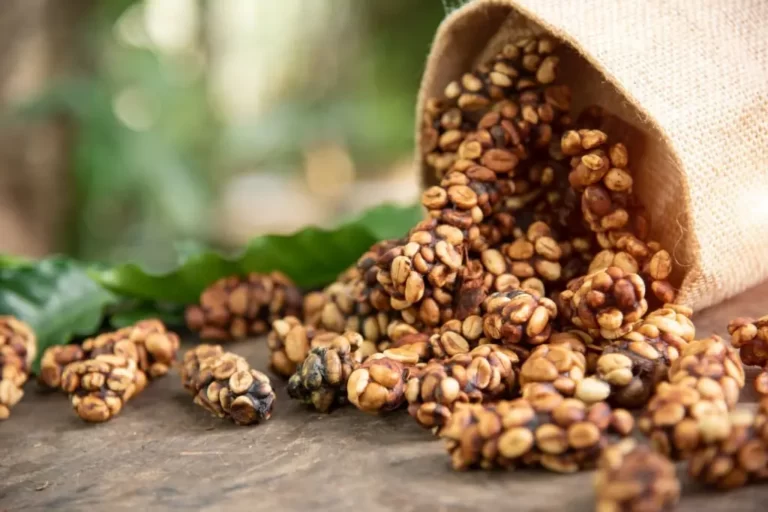Kopi Luwak Coffee is considered to be the most exclusive coffee in the world. Or should I say “cat-poo-ccino”? You will be shocked to know its production process.
As my earlier pun suggests, kopi Luwak coffee is, you guessed it, cat poop coffee. Palm Civet poop, if you want to be specific about it.
But why, and how did this waste material from a wild animal become a delicacy?
Here, we’re not talking about a common bean that you go and buy at Walmart, let alone drink every morning. Instead, this is something that coffee connoisseurs would be willing to lighten their wallets for.
So, What Is Kopi Luwak?
Kopi Luwak coffee is of Indonesian origin. Imagine a beautiful sunset in tropical Indonesia. The last bit of sun-rays lights up the red berries of the coffee tree. A cat-like animal, Asian palm civet, crawls out of the bush. It begins to chew on the ripe coffee cherries.
Somewhen during the night, the animal poops. Things get interesting when people go and collect the poop. And voila! It’s the world’s most expensive coffee. So, then, can we call it ‘Poop Coffee’? Yes we can, cause that’s technically the truth.
Kopi Luwak coffee beans have to go through the digestive process of a palm civet. Crazy, right?

These beans can run for $2000 per kg. In addition, the digestive enzymes from the civet’s intestine help break down the bean proteins, adding to the taste and flavor.
History of Kopi Luwak
The journey of Kopi Luwak began in the 19th century. During this time, the Netherlands controlled coffee production in the country. As a result, the local workers were not allowed to collect the coffee fruit from trees.
So, they found their ways to produce coffee without making the Dutch plantation owners angry. They gathered the undigested coffee seeds from the civet’s droppings and washed and roasted them. Later it became today’s kopi Luwak coffee which soon became a valuable commodity for coffee drinkers.
Learn About Palm Civets
The Asian palm civet is a nocturnal animal found throughout South East Asia. It spends most of its life lonely up in trees. The palm civet enjoys insects, bird eggs, fruit, and of course, coffee berries.
Palm civets look like a cross between a cat and a raccoon. It is the size of a cat and has black-masked eyes like a raccoon. It also has a long, narrow tail.

With a civet cat’s incredible smelling sense, it picks the sweetest and ripest coffee cherries, the prime source of high-quality coffee beans. It then digests the coffee cherry pulp. But the seed remains almost intact and begins to ferment.
The digestive tract’s enzymes help remove some of the acidity and bitterness from the coffee, which gives the Kopi Luwak a specific soft taste. Within a day or two, the seeds come out covered in feces. They look more like nutty snickers. The coffee farmers collect them and separate the beans from the wastes for kopi Luwak production.
The Production Journey
It may not sound so lucrative to drink a poop coffee. But, would you enjoy a cup of coffee whose beans have been collected from animal feces? Maybe not, but the beans are washed very thoroughly, and you can take my word for it.
The cleaning process involves washing in several batches before it is placed in direct sunlight. It dries out after being out in the sun for a couple of days.
Then they start manual processing methods and remove the outer shell. And grind the contents to get the inner core out—a very time-consuming process.
Then all excess peel and damaged beans are hand-sorted out from the beans. What remains now is the final product needed to be roasted and ground. The beans get roasted at 428 oF.
The beans lose 80% percent of their total weight when the process is completed. Twenty kilos of ready-roasted palm civet coffee will be left from 100 kilos of beans.
Should You Drink It?

This is the point where you want to ask me questions like: “Will I get sick from the wild civet coffee?” Fear not; there is no danger.
These coffee beans are processed very well. The beans end up having no bacterial contamination. You can safely drink it, even safer than regular coffee beans.
Having fun Nomies? Check out our piece on all about americano coffee.
Flavor Profile
Kopi Luwak coffee taste has dark chocolate and caramel hints that linger in your mouth for a while. The taste reminds you of rich dark syrup.
According to coffee experts, kopi Luwak coffee gives an earthy and musty taste. That stays in the aftertaste too.
There is no bitter taste. On the contrary, the caffeine content in it is much milder than a regular cup of coffee. It also gets a fruity and floral note.
So, are you wondering whether the most expensive cup of coffee is also tastier or not? Well, it’s up to you to decide!
The Cost
Kopi Luwak coffee costs between $100-$2800 per kilo, depending on whether the animals are wild palm civets or caged. So the price per cup of good poop coffee is around $4. In contrast, natural wild kopi Luwak coffee can cost you even more.
The wild variation, aka the best kopi Luwak coffee variation has a price between $35- $100.
The high-quality bean from wild civets may cost $1490 –$2800 per kilogram, whereas farmed ones cost only $100-$300.
It’s like paying for coffee at a five-star hotel. Yet you are at home, brewing the cup in your coffee maker. Of course, we’re talking about the world’s most expensive coffee, duh! While speaking of expensive coffee, the next question comes to mind.
Why Is Kopi Luwak So Expensive?
Kopi Luwak coffee beans are rare and produced in a small quantity annually. The hefty price tag comes from low supply and high demand. But why is there such a limited supply of the bean?
The number of palm civets is limited worldwide. The wild civets roam freely at night. So to collect a good amount of beans, the farmers require good territory knowledge and a bit of good luck, which makes the job quite tricky.
Moreover, civets don’t eat baskets of cherries for us to drink coffee out of. So civets can only produce a certain amount of this bean per year, ranging between 250 to 500 kilograms in total. This much of annual production is yet too low against the high demand.
The Disturbing Truth
The natural process of Luwak bean production is time-consuming and not always a successful job. Therefore, to meet the high demand and keep the kopi Luwak industry alive, many manufacturers chose animal cruelty above the animal welfare.
People catch palm civets in small cages on coffee plantations where they are forcibly fed coffee berries. That way, the farmers have safe access to feces. But the civets live in inhumane conditions.
The otherwise nocturnal civets who love living alone now spend all day awake. They are caged in small areas in close contact with both humans and other civets. It causes them enormous stress and suffering.
Some lose weight due to only eating coffee cherries. Others became obese from living in tiny cages and not moving freely.
These inhuman and artificial living conditions often result in the demise of the unfortunate civet, causing the civet population to dwindle every day. Despite attempts being made to reduce artificial civet coffee farms, they still exist today.
This is heartbreaking, to say the least. No matter how much of a wonderful coffee Kopi Luwak is, this behavior towards the civets is unacceptable.
Had fun reading? You’ll love to read our piece on what is vietnamese coffee.
Final Thoughts
One thing is for sure; Only coffee aficionados dare to taste this exclusive coffee. Would you like to try it?
Even if you do, make sure to buy from a wild coffee plantation where the animals can go free and feel good! Don’t forget to watch out for replicas peddled out by some coffee companies as well.
Critics believe that Kopi Luwak is a fairy tale that’s sold at a great price only for the story. But remember, fairy tales are real.
Every morning, we drink a tonic made from magic beans. It may not be civet cat coffee, but any good coffee is no less than Manna from heaven for a coffee lover.
FAQs
The coffee has a round and smooth taste. It gives an earthy and musty taste with hints of dark chocolate, caramel, fruit, and floral notes.
Yes, it’s 100% safe.
No. The Asian palm civet is a shy and nocturnal animal.
The real Kopi Luwak producing farms will brag about it, making it easier to find.
A cup of Kopi Luwak is unique because of its delicious, heavenly taste, partly due to the beans coming from the ripest and sweetest cherries.

